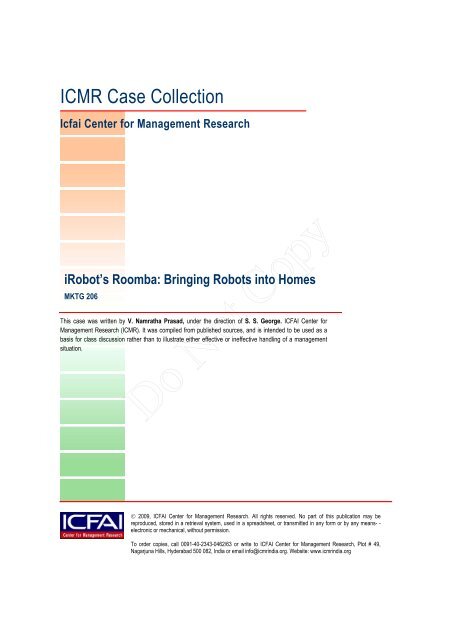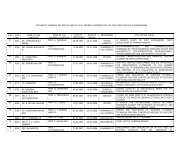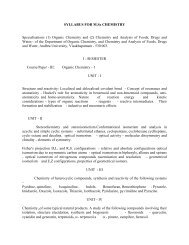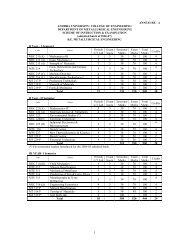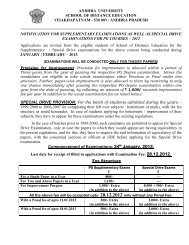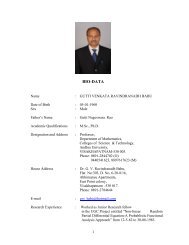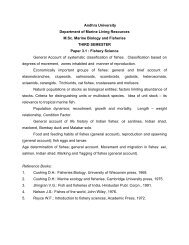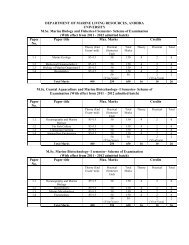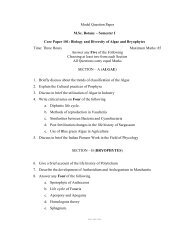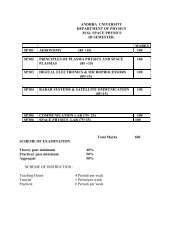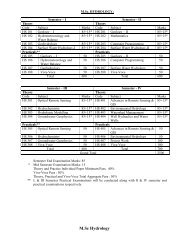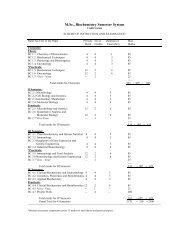Do Not Copy - Andhra University, Visakhapatnam
Do Not Copy - Andhra University, Visakhapatnam
Do Not Copy - Andhra University, Visakhapatnam
Create successful ePaper yourself
Turn your PDF publications into a flip-book with our unique Google optimized e-Paper software.
ICMR Case Collection<br />
Icfai Center for Management Research<br />
iRobot’s Roomba: Bringing Robots into Homes<br />
MKTG 206<br />
This case was written by V. Namratha Prasad, under the direction of S. S. George. ICFAI Center for<br />
Management Research (ICMR). It was compiled from published sources, and is intended to be used as a<br />
basis for class discussion rather than to illustrate either effective or ineffective handling of a management<br />
situation.<br />
<strong>Do</strong> <strong>Not</strong> <strong>Copy</strong><br />
© 2009, ICFAI Center for Management Research. All rights reserved. No part of this publication may be<br />
reproduced, stored in a retrieval system, used in a spreadsheet, or transmitted in any form or by any means- -<br />
electronic or mechanical, without permission.<br />
To order copies, call 0091-40-2343-0462/63 or write to ICFAI Center for Management Research, Plot # 49,<br />
Nagarjuna Hills, Hyderabad 500 082, India or email info@icmrindia.org. Website: www.icmrindia.org
iRobot’s Roomba: Bringing Robots into Homes<br />
1<br />
MKTG/206<br />
“(It’s) one of the first practical robot stores ever to be in existence that wasn’t focused on meeting<br />
the needs of the hobbyist. I think it is an important milestone in our industry.” 1<br />
-Colin Angle, Chief Executive Officer of iRobot in 2008.<br />
“Today, people say, ‘That’s not a robot, that’s a vacuum,’ or, ‘that’s not a robot, that’s an<br />
unmanned ground vehicle in the military. But they all are robots. We want to make sure people<br />
understand this is a new emerging technology with a large number of areas that it can be adopted<br />
in. And at iRobot, we’ve taken some of the good first steps”. 2<br />
INTRODUCTION<br />
- Helen Greiner, Former Chairman and Co-founder of iRobot in 2005.<br />
In November 2008, iRobot Corporation (iRobot) announced the opening of a retail kiosk in<br />
Burlington Mall near its headquarters in Bedford, Massachusetts. The kiosk was open from<br />
November 07, 2008, to January 15, 2009. It was managed by trained company staff, and offered<br />
live demonstrations of the various commercial robots manufactured by the company.<br />
iRobot expected the kiosk to generate interest in the company’s commercial robots, and<br />
consequently increase sales. It also considered the kiosk to be a low-risk, low-cost way of testing a<br />
possible future retail strategy. Colin Angle, Chief Executive Officer of iRobot, said, “As we roll<br />
the clock forward you’re going to see more and more home robots…and the concept of a robot<br />
store is going to be something that every mall is going to want to have.” 3<br />
iRobot was established in 1990, to create practical applications for robots. The company started<br />
out making robots for research purposes, an activity which yielded poor returns. It became more<br />
successful when it began manufacturing robots for use by the military. However, the product that<br />
brought the company worldwide recognition was the iRobot Roomba, a floor cleaning robot which<br />
was introduced in September 2002 and was hailed as a major innovation. .<br />
The Roomba was developed after years of research, during which time iRobot developed the<br />
complete design of the robot including a unique vacuuming system, and navigation and artificial<br />
intelligence software. Over the years, the Roomba made it to several best product lists and came to<br />
be sold in several countries around the world. iRobot also launched several line extensions of the<br />
Roomba, including another popular commercial robot, the floor scrubbing Scooba.<br />
By 2004, iRobot had sold over one million Roombas. The company, which had struggled to get<br />
venture capital funding in its early stages, had a highly successful IPO in 2005. In 2007, iRobot<br />
introduced the iRobot Create, a robot with a standard hardware platform that other people could<br />
use to make further improvements or add extensions.<br />
<strong>Do</strong> <strong>Not</strong> <strong>Copy</strong><br />
1<br />
Robert Buderi, “A Robot Store in Every Mall? iRobot CEO Discuss Firm’s Efforts to Boost Retail Sales,”<br />
www.xconomy.com, November 12, 2008.<br />
2<br />
Mark Jewell, “The woman who creates robots,” www.rediff.com, May 30, 2005.<br />
3<br />
Robert Buderi, “A Robot Store in Every Mall? iRobot CEO Discuss Firm’s Efforts to Boost Retail Sales,”<br />
www.xconomy.com, November 12, 2008.
iRobot’s Roomba: Bringing Robots into Homes<br />
As there were no other robotic floor cleaners, the Roomba’s competition came from low-end<br />
vacuum cleaners. Analysts considered the Roomba to be a good value proposition, but some of<br />
them also believed that iRobot could have marketed it more effectively.<br />
In late 2008, when the sales of the Roomba began to decline, iRobot decided to test out a new<br />
retail strategy for its robots. As a first step, it opened the retail kiosk to offer live demonstrations of<br />
the Roomba to get customers interested in the robots and to purchase them online.<br />
BACKGROUND NOTE<br />
iRobot was founded in 1990 by Dr. Rodney Brooks (Brooks), Colin Angle (Angle), and Helen<br />
Greiner (Greiner). The company was named after ‘I, Robot’ 4 a well-known book by science fiction<br />
writer Isaac Asimov 5 . The trio met in the 1980s, while working at the Massachusetts Institute of<br />
Technology (MIT)’s Computer Science and Artificial Intelligence Lab (CSAIL), where they used<br />
to develop robots.<br />
The three founders came from diverse backgrounds. While Brooks was doing research in artificialintelligence,<br />
Angle had earlier designed unmanned extraterrestrial vehicles, and Greiner had<br />
experience in developing robots for research purposes.<br />
iRobot was formed to develop practical, commercial applications for robots. Greiner later said,<br />
“We are not there to do demonstrations of technology. We are not there to talk about stuff that’s<br />
going to happen 50 years from now in robots -- although that’s going to be extremely exciting. We<br />
really concentrate on practical and affordable systems for today.” 6 The goal of the company was<br />
specified to be the creation of affordable robots that could perform dull, dirty, and dangerous jobs,<br />
safely and efficiently. The mission statement of iRobot was, “Build cool stuff, deliver great<br />
product, make money, have fun, and change the world.”<br />
The company’s initial years were spent designing experimental robots for research purposes. In<br />
1991, iRobot’s first products — six-legged walking machines called Genghis and Attila, with<br />
numerous onboard computers and several infrared sensors 7 — were developed as tools for robotics<br />
researchers. But the founders soon realized that the returns from selling robots for research<br />
purposes were very low, and did not even cover the costs for manufacture. To make up for the<br />
shortfall, they used up the credit limits on their credit cards and even took bank loans of up to US$<br />
100,000.<br />
<strong>Do</strong> <strong>Not</strong> <strong>Copy</strong><br />
Over the years, iRobot worked with companies like S.C. Johnson & Son Inc. (Johnson) 8 and<br />
toymaker Hasbro Inc. (Hasbro) 9 to develop devices that could be mass marketed. Later, Johnson<br />
backed out of the collaboration with iRobot, even before the robotic floor cleaner which they were<br />
working on made it to production. After some time, iRobot’s second collaboration also ended,<br />
when the life-like doll and the robotic velociraptor (a type of dinosaur) it had developed for Hasbro<br />
met with poor sales.<br />
4 ‘I, Robot’ written by Issac Asimov, is a collection of nine science fiction short stories based on robots.<br />
5 Issac Asimov (1920-1992) was a highly successful American writer who was famous for his work in science fiction.<br />
He is credited with coining the term ‘Robotics’.<br />
6 “Is There a Robot in Your Future? Helen Greiner Thinks So,” http://knowledge.wharton.upenn.edu, April 5, 2006.<br />
7 In an infrared sensor, a narrow band infrared beam is transmitted from a Light Emitting Diode (LED). When the beam<br />
strikes an object in its path, it is reflected back onto the Position Sensitive Detector (PSD). This helps the sensor<br />
detect the position and distance of a particular object from it.<br />
8 The company is the largest component of the Johnson Family Enterprises. It is a manufacturer of household cleaners<br />
like Windex and Pledge, and other consumer chemicals.<br />
9 Hasbro is the second largest toy manufacturer in the world after Mattel. An American company, it is also the<br />
publisher of several popular board games, including Monopoly.<br />
2
iRobot’s Roomba: Bringing Robots into Homes<br />
iRobot finally found a measure of success when the robots it developed began to be used by the<br />
military. In 1993, the company was engaged by the US Department of Defense and the Office of<br />
Naval Research to develop an underwater minesweeper. In 1996, iRobot developed Ariel, a robot<br />
which has crab-like legs that helped it remain upright and to easily maneuver itself over hurdles.<br />
Ariel was mainly used to locate and disable mines in war zones both on the ground and under<br />
water.<br />
In order to meet its research and manufacturing costs, iRobot needed a further infusion of capital.<br />
However, the company found it extremely difficult to get any funding from venture capital firms.<br />
It was only in 1998 that it was able to attract funds from five venture capital funds — Trident<br />
Capital, Fenway Partners, First Albany Corp., iD Ventures, and Robotic Ventures. Greiner later<br />
said, “When we started the company we were un-fundable from a venture capital point of view. It<br />
was really not until eight years in that we even tried to get venture capital funding. I can say that I<br />
have been turned down by almost every major VC in the country, except for the five really<br />
visionary, farsighted ones who joined us.” 10 Over the next six years, iRobot raised almost US$ 38<br />
million in venture capital.<br />
In 1998, iRobot won a DARPA 11 contract for the tactical mobile robot program. The work on this<br />
program eventually led to the development of an autonomous mobile robot, called the iRobot<br />
PackBot (PackBot). The PackBot resembled a small tank and had the ability to climb stairs and<br />
work under water. (See Exhibit I for a picture of the PackBot). In 2001, the PackBot was used<br />
for the first time in a real-life environment when it was used to search the rubble of the World<br />
Trade Center in New York City, after the September 11 terrorist attacks.<br />
The PackBot design was later improved to detect bombs and booby traps in hostile situations. The<br />
robot was fitted with still cameras, live video cameras, and a robotic arm. It had the ability to<br />
transmit information about what lay ahead of it, and could also explode improvised explosive<br />
devices (IEDs), detect land mines, and retrieve hazardous materials. In June 2002, the PackBot<br />
was used in Afghanistan to search caves for hostile forces and to detect hidden stores of<br />
ammunition.<br />
In September 2002, iRobot in collaboration with the National Geographic Society 12 developed a<br />
robot to explore one of the shafts of the Great Pyramid of Giza in Egypt. In the same month,<br />
iRobot introduced the Roomba, which became the first robot to be mass marketed at an affordable<br />
price.<br />
iRobot continued to develop several innovative robots for the US military as well as the consumer<br />
market. In April 2004, it entered into a contract to build a Small Unmanned Ground Vehicle<br />
(SUGV) for the U.S. Army’s Future Combat Systems program.<br />
In November 2005, iRobot raised US$ 103.2 million through its IPO and began trading on the<br />
NASDAQ under the symbol ‘IRBT.’. The IPO was successful and in the initial weeks of trading,<br />
the share price touched a high of US$ 34.16, much to the surprise of some market watchers. Eliot<br />
Menendez, an analyst, said, “A lot of people didn’t expect a robotics IPO would do so well.” 13<br />
As of 2008, iRobot claimed to have seven products in its line-up of commercial robots and about<br />
eight types of military and industrial robots. (See Exhibit II for details of iRobot’s products). By<br />
then, around 60% of iRobot’s revenue was derived from the sale of commercial robots, and the rest<br />
<strong>Do</strong> <strong>Not</strong> <strong>Copy</strong><br />
10 “Leading with Resilience: iRobot’s Helen Greiner,” http://leadership.wharton.upenn.edu, April 2006.<br />
11 Defense Advanced Research Projects Agency (DARPA) is an agency of the United States Department of Defense. It<br />
mainly funds small short duration projects to help develop new technology for use by the US military.<br />
12 The NSG is one of the largest non-profit scientific and educational institutions in the world. It publishes several<br />
magazines including its flagship publication, The National Geographic Magazine. It also runs a television channel and<br />
extends support to several projects in the fields of geography, archaeology, natural science, environmental and<br />
historical conservation, world culture and history. (Source: Compiled from various sources)<br />
13 Robert Weisman, “IRobot shares jump 11.25% in trading debut,” www.boston.com, November 10, 2005.<br />
3
iRobot’s Roomba: Bringing Robots into Homes<br />
from military and industrial robots. By December 2008, iRobot had sold about 2,000 units of the<br />
Packbot at a price ranging from US$ 50,000 to US$ 115,000 apiece. It had also sold more than 2.5<br />
million units of the Roomba.<br />
DESIGN AND DEVELOPMENT<br />
iRobot believed that the Roomba, its flagship product, was the first practical and affordable home<br />
robot. Since its inception, iRobot had been working on developing a robot that could clean floors.<br />
The initial goal was to create a mechanical sweeper that worked well, was easy to use, and cheap.<br />
The eight-member iRobot team consisting of the founding members among others, started work on<br />
the Roomba only in 1999.<br />
While developing the robot, the team never lost sight of the fact that they were building a robot<br />
that was to be marketed as a household appliance. By working with several focus groups, the team<br />
realized that people were quite choosy when buying appliances, compared to purchase decisions<br />
for devices like computers. They discovered that people wanted appliances that were not only<br />
cheap, but also simple and reliable. This provided the team with a totally different perspective<br />
during the development process, which they later said, came as a ‘culture shock.’<br />
The team spent a lot of time studying industrial cleaning equipment, and finally settled on a discshaped<br />
design for the robot, with a low height that would enable it to slip easily under furniture.<br />
The team discovered that apart from the mechanics, the kind of brushes used for cleaning and the<br />
type of plastics used in the manufacture of the robot affected the performance of the robot. There<br />
were long discussions regarding the kind of parts to be used in order to keep the overall cost of the<br />
robot low. Angle later said, “We had to learn about plastics. We had to learn about Far East<br />
manufacturing. We learned that if you haven’t had a sit-down, drag-out, pound-on-the-table<br />
argument over a nickel, you don’t understand consumer products.” 14<br />
The team tried out over 40 brushes of different lengths, curvatures, and density of bristles before<br />
selecting the most suitable ones. The robot was finally fitted with rotating brushes that could pick<br />
up dirt from both hard and soft surfaces.<br />
In the initial stages, the team did not consider having vacuum power for its robot. This feature was<br />
incorporated after a focus group stated that they would pay more for a cleaning robot which could<br />
vacuum. For this purpose, the team sought the services of a vacuum consultant, who informed<br />
them that vacuum cleaners were more art than science. Paul Sandin, a team member said, “It<br />
would’ve been nicer to have some math to go by.” 15<br />
The team therefore had to resort to trial and error to create the right vacuuming technique for the<br />
<strong>Do</strong> <strong>Not</strong> <strong>Copy</strong><br />
robot. While developing the new vacuuming system, the team also had to keep in mind the fact<br />
that the robot had to run on rechargeable batteries. Therefore, although normal vacuum cleaners<br />
consumed a lot of power, the team developed a new vacuuming system that required less power.<br />
The robot had a three part cleaning system. A flapper and brush system was used to trap large<br />
particles, while the nozzle of the vacuum was used to suck up small particles like dust. To remove<br />
debris from hard to reach places like the bases of walls and corners, an edge-cleaning spinning side<br />
brush was used. The collected trash was stored in an easily removable dustbin in the robot’s rear.<br />
To enable the robot to move around, it was fitted with a powerful motor and three wheels -- two<br />
drive wheels and a caster. Each wheel was fitted with a drop sensor. The wheels were made of<br />
soft, knobbed rubber to facilitate progress across any type of flooring. To test the mobility of their<br />
robot, the team ran it over ‘torture tracks’.<br />
14 Lev Grossman, “Maid to Order,” www.time.com, September 14, 2002.<br />
15 “How the Roomba Was Realized,” www.businessweek.com, October 6, 2003.<br />
4
iRobot’s Roomba: Bringing Robots into Homes<br />
iRobot also developed the navigation and artificial intelligence software for the robot, taking<br />
insects as inspiration. Brooks felt that robots, like insects, had to be equipped with simple control<br />
mechanisms, which were tuned to their environments. All the robots created by the company used<br />
the AWARE Robot Intelligence System, its proprietary technology. AWARE used several infrared<br />
sensors to monitor the environment, sending the data to the robot’s microprocessor and then<br />
adjusting its behavior up to 67 times per second. This system enabled the robots to make their own<br />
decisions and to find their way around complex environments.<br />
The robot had about as much computing power as a game controller. It did not map out the floor of<br />
the room it cleaned, but relied on a number of simple movements like moving in a widening spiral<br />
pattern, following walls, and rotating in concentric circles and moving away when it hit an object<br />
in its path. For detecting objects in its path, the front half of the robot was fitted with a big contactsensing<br />
bumper.<br />
The robot also had an infrared sensor fitted on the top front center in addition to four infrared<br />
sensors on the bottom (pointing downwards) to stop it from falling down stairs or other elevated<br />
areas. This also ensured that the robot did not damage anything in its environment. Greiner later<br />
said, “The robot (Roomba) is very lightweight, so it’s not heavy enough to cause damage. It first<br />
protects itself with its downward-pointing infrareds. If that doesn’t work, one of the wheel-drop<br />
sensors will detect the edge. And if that doesn’t work, it’s got a high-friction pad on the back that<br />
keeps it from going over. Building in a lot of redundancy, keeping it lightweight, and keeping it<br />
very safe from the beginning of the project have been important.” 16<br />
The robot was also designed to function within infrared transmitter units called ‘Virtual Walls’.<br />
The Virtual Wall units sent out infrared signals that were picked up by the robot through the<br />
receiver on its bumper. When it picked up a signal, the robot would turn around and move away.<br />
This feature enabled customers to set limits on the movement of the robot within a house or room,<br />
stopping it from wandering into certain rooms or areas.<br />
The initial design for the robot had to be reworked almost 20 times before it was perfected. The<br />
complex final design consisted of 100 plastic parts, motors, controllers, sensors, brushes (bristle<br />
and rubber) and a dustbin. The disc-shaped robot weighed 5-lb. 10-oz., and was 3.5 inches high<br />
and 13.5 inches wide. It was named the ‘Roomba,’ as the development team felt that the robot’s<br />
circular motion resembled the Rumba, a dance style (See Exhibit III for pictures of the first<br />
generation Roomba).<br />
<strong>Do</strong> <strong>Not</strong> <strong>Copy</strong><br />
To keep manufacturing costs low, iRobot decided to manufacture the Roomba in Southern China.<br />
This enabled the company to sell the Roomba for US$ 199.99, which was considered a<br />
competitive price.<br />
The Roomba had other features designed to increase its appeal. It was fitted with three buttons for<br />
the customer to input the size of the room (small, medium, or large). When put to work, after a<br />
certain predetermined period of time, the Roomba would emit triumphant sounds signaling that its<br />
work was over. And, if at any time during its cleaning process, it no longer sensed the floor<br />
immediately beneath it or sensed that it was trapped with no means of escape, it would make a<br />
mournful sound to alert its owner.<br />
16 “Is There a Robot in Your Future? Helen Greiner Thinks So,” www.ftpress.com, June 2, 2006.<br />
5
BRINGING THE ROOMBA INTO HOMES<br />
iRobot’s Roomba: Bringing Robots into Homes<br />
The manufacture of the Roomba, based on its final design, raised several challenges for iRobot’s<br />
Hong Kong-based contract manufacturer, Jetta Co. (Jetta). The development team expected the<br />
production issues to be resolved in two weeks, but the process took four months. Angle said,<br />
“Every day, there’d be a list of problems 50 items long. The minutiae were terrifying.” 17<br />
iRobot adopted a cautious approach to marketing the Roomba. To reduce the amount of cash tied<br />
up in inventory, iRobot’s first order was for a shipment of 15,000 Roombas, with an additional<br />
10,000 if the response to the product was good. iRobot marketed the Roomba as an ‘Intelligent<br />
Floor Vacuum’ rather than as a robot, to make it more approachable and appealing for an average<br />
customer. It was mainly advertised through a 28-minute infomercial aired on Home Shopping<br />
Network (HSN) 18 . This was considered a risky move, as infomercials were commonly used for<br />
products that were priced below US$ 30.<br />
iRobot found it difficult to find retailers to sell the Roomba. Several retailers, whom iRobot<br />
approached, refused to sell the Roomba. The company then approached specialty retailers like<br />
Brookstone Inc. (Brookstone) 19 and The Sharper Image 20 and managed to convince them to carry<br />
the Roomba. Later, iRobot trained the salespeople at these retail stores to give demonstrations of<br />
the Roomba to the public.<br />
In September 2002, when the Roomba finally became available to the public, it met with a positive<br />
response, and even figured on several ‘Best Product’ lists for the year. It received the Good<br />
Housekeeping Seal 21 in addition to awards like Time Magazine’s ‘Coolest Inventions’ and Popular<br />
Science’s ‘Best of What’s New.’<br />
The Roomba was sold out within a few days of its release. Brookstone, which ran out of Roombas,<br />
was so eager to re-stock them that it footed the bill to fly them in from Hong Kong. The good sales<br />
of Roomba also prompted more retailers to come forward to stock the product. In addition, the<br />
infomercial that was aired on HSN was also successful, and generated sales of 4,000 units in two<br />
days. In the first year, about 200,000 units of Roombas were sold, mostly driven by positive press<br />
reviews and customer buzz.<br />
In 2003, iRobot developed and strengthened its marketing and distribution system. It also roped in<br />
more retailers to sell the Roomba. In March 2003, it recruited an experienced consumer-appliance<br />
marketer Gregory F. White (White) to help market the Roomba.<br />
White decided that iRobot needed to maintain a stock of 70,000 Roombas to properly meet the<br />
demand and keep the retailers stocked. He also spent US$ 7.5 million on purchasing prime-time ad<br />
spots on TV to air Roomba commercials. The marketing tag line used in the ad was: “If it’s down<br />
there, we’ll get it.” By late 2003, Roomba was available in 4,000 outlets across the US, including<br />
several major retail chains.<br />
EXPANDING THE MARKET<br />
<strong>Do</strong> <strong>Not</strong> <strong>Copy</strong><br />
iRobot continued to improve upon the original Roomba. It introduced several new features for the<br />
next generation of Roombas, called the Roomba Discovery Series, launched in September 2004. It<br />
introduced features like a self charging home base (to help the Roomba find the charger and<br />
recharge its battery on its own), dirt sensors (to detect areas that were dirtier), a scheduler, and a<br />
remote control.<br />
17<br />
“How the Roomba Was Realized,” www.businessweek.com, October 6, 2003.<br />
18<br />
HSN is a 24-hour cable shopping network in the US.<br />
19<br />
Brookstone is a chain of retail stores in the US that was started in 1973. It specializes in selling electronic gadgets.<br />
20<br />
The Sharper Image was a chain of retail stores in the US that was started in 1977. It filed for bankruptcy and was<br />
liquidated in 2008.<br />
21<br />
The Seal was given by the women’s magazine ‘Good Housekeeping’.<br />
6
iRobot’s Roomba: Bringing Robots into Homes<br />
It also introduced a number of models in different price ranges to appeal to more customers (See<br />
Exhibit IV for information on three generations of Roomba). Angle said, “The key to going<br />
from one or two models to ‘many’ is that all of these robots have common software, common<br />
interfaces, common controllers, so that if you develop for one, you know how to develop for all of<br />
the weight classes.” 22 The newer models ranged from US$ 199 to US$ 500 in price.<br />
By 2004, in addition to retail stores and HSN, iRobot sold the Roombas through websites like<br />
Amazon, eBay, and its own websites, www.roombavac.com and www.irobot.com. iRobot claimed<br />
that by October 2004, 1 million Roombas had been sold.<br />
In an attempt to further diversify the commercial robot line, iRobot introduced a floor washing<br />
robot Scooba (derived from ‘scrub’ and ‘room’) in May 2005. The Scooba had the same physical<br />
appearance as that of Roomba (See Exhibit V for a picture of the Scooba). iRobot teamed up<br />
with Clorox 23 to develop the unique cleaning solution needed for Scooba. Greiner said, “It turns<br />
out the soap for a robot floor-washing system has to be high traction. When you put soap on the<br />
floor it’s slippery, which is exactly the wrong thing. So their engineers and ours worked together,<br />
to make a high traction soap [that] cleans really well.” 24<br />
The Scooba was also positively received. In 2005, it was recognized as one of Time magazine’s<br />
‘Most Amazing Inventions.’ It also won the International Consumer Electronic Showcase (CES)<br />
‘Best of Innovation’ award in the Home Appliance category.<br />
In 2005, iRobot launched an integrated marketing campaign called ‘I Love Robots.’ The campaign<br />
utilized print, cable, television, and outdoor advertising, and direct marketing, and showed people<br />
who owned the Roomba and the Scooba talking about their good experiences with the robots.<br />
White said, “We really wanted an ad campaign that conveyed the excitement and enthusiasm our<br />
customers feel for their robots. The ‘I Love Robots’ campaign showcases that passion first hand,<br />
with people speaking sincerely and unscripted about the robots.” 25<br />
In addition to the US, iRobot attempted to sell the Roombas in countries like Canada, Korea, and<br />
Japan. It also developed a Google AdWords campaign to attract online customers. Roomba<br />
became the 7 th most-searched brand on Google in the US in 2005 and also showed a significant<br />
increase in sales.<br />
iRobot continued to introduce new robots for specific cleaning purposes. In September 2006, it<br />
introduced the iRobot Dirt <strong>Do</strong>g (See Exhibit VI for a picture of the Dirt <strong>Do</strong>g), which was<br />
marketed as a ‘workshop’ robot with a powerful brush to pick up small nuts, bolts, and other shop<br />
floor debris. It was to be used in places like garages, basements, and workbench areas, which<br />
needed heavy duty cleaners.<br />
A ROBOT IN EVERY HOME<br />
<strong>Do</strong> <strong>Not</strong> <strong>Copy</strong><br />
According to Greiner, it took black-and-white TVs six years, mobile phones four years, VCRs five<br />
years, and air-conditioners seven years to cross the threshold of the one million sale mark. The<br />
Roomba had surpassed that figure in two years. Greiner said, “All of these devices that people now<br />
consider indispensable were adopted at much slower rates. The question is no longer; will you<br />
have a robot in your home in the future? But instead, How many?” 26<br />
22<br />
Rich Smith, “Fool on the Street: iRobot is Mutating,” www.fool.com, August 16, 2007.<br />
23<br />
Clorox, founded in 1919 in US, is a major manufacturer of household cleaning products, which includes a highly<br />
popular bleach product.<br />
24<br />
“Is There a Robot in Your Future? Helen Greiner Thinks So,” http://knowledge.wharton.upenn.edu, April 5, 2006.<br />
25 “iRobot Kicks Off “I Love Robots” Ad Campaign,” www.allbusiness.com, October 3, 2005.<br />
26 Matt Hines, “Robotics industry hypes drive to market,” http://news.cnet.com, May 10, 2005.<br />
7
iRobot’s Roomba: Bringing Robots into Homes<br />
By 2006, iRobot claimed to have sold 2 million units of Roomba worldwide. White said, “Selling<br />
2 million Roomba Vacuuming Robots is not just a milestone for iRobot, but for the robot industry<br />
as a whole. This achievement signifies that more and more consumers are adopting robots in their<br />
everyday lives, thereby liberating themselves from mundane household chores and spending more<br />
time with family and friends.” 27<br />
iRobot claimed that the Roomba was seen not only as a useful addition to a household, but was<br />
even treated as a family pet by certain customers. Nancy Dussault, VP of marketing at iRobot,<br />
said, “When we talked to consumers about their robots, we found they were referring to them as<br />
‘he’ or ‘she’ and, that they often had names for them. Robots were coming into customer service<br />
with beautiful paint jobs. We were shocked.” 28<br />
iRobot also discovered that some of its technically-savvy customers found ways to hack into the<br />
Roomba and reprogram it to bring a thrown ball or play with a cat. Analysts pointed out that the<br />
core engine of Roomba was very good at moving around, and this helped iRobot develop product<br />
line extensions by building upon the platform of robotic locomotion. Using the same core<br />
functionality, customers were innovating to develop new applications for Roomba.<br />
On its part, iRobot realized the value of such hacking, believing that customer innovation would<br />
prove to be an asset to the company. Initially, the company added a serial port to the Roomba,<br />
which allowed customers to plug in and re-program the robot.<br />
Later in January 2007, iRobot introduced a basic version of the Roomba called the ‘iRobot<br />
Create’, which was intended to be a standard hardware platform for developers. Greiner said, “We<br />
have created a robotics development environment that fulfills a need in the industry for a standard<br />
hardware platform on which to develop new mobile robots. We want to put iRobot at the center of<br />
the ecosystem.” 29<br />
The Create platform could be used with a range of programming languages and systems. It was<br />
priced at US$ 129, and contained the Roomba shell and a command system to allow developers to<br />
bring in added functionality. Over time, iRobot added a line of attachments to extend that platform<br />
by including a robotic arm and a holographic projector.<br />
iRobot featured the innovations of its customers on the webpage ‘iRobot Create Laboratory’, and<br />
customer discussions regarding Roomba and Create were encouraged in the forums section on the<br />
website (www.roombacommunity.com). The website also had a section in which iRobot provided<br />
pictures of the internals of the Roomba and invited users to make suggestions for replacing certain<br />
parts.<br />
Industry analysts lauded iRobot’s support of customer innovation on its core platform. They felt<br />
that this would help new product development in the robotics industry and also raise overall<br />
customer interest in robotic products. They also believed that it was a good way for the company<br />
to develop new product ideas, license the best ideas developed, and hire the most innovative<br />
developers, while keeping down R&D costs. An article on iRobot’s efforts commented, “We often<br />
don’t see the game-changing potential of our own inventions, but must leave it to customers to<br />
point it out to us. In letting go of our perceived monopoly on innovation, we unlock our true<br />
innovative potential.” 30<br />
<strong>Do</strong> <strong>Not</strong> <strong>Copy</strong><br />
27<br />
“Sales of iRobot Roomba Vacuuming Robot Surpass 2 Million Units,” www.businesswire.com, May 22, 2006.<br />
28<br />
“How a Little Robot Became a Platform for Innovation,” http://innovations.ziffdavisenterprise.com, July 3, 2007.<br />
29<br />
Priya Ganapati, “iRobot Still Wants to Bat Cleanup,” www.thestreet.com, January 9, 2007.<br />
30<br />
“How a Little Robot Became a Platform for Innovation,” http://innovations.ziffdavisenterprise.com, July 3, 2007.<br />
8
iRobot’s Roomba: Bringing Robots into Homes<br />
In 2007, iRobot introduced several new commercial robots. In April 2007, the company released<br />
the iRobot Verro Pool Cleaning Robot. In August 2007, it launched the Roomba 500 Series<br />
Vacuum Cleaning Robots, a new generation of Roombas with some novel features. In September<br />
2007, iRobot unveiled the Looj Gutter Cleaning Robot and ConnectR Virtual Visiting Robot<br />
(ConnectR). ConnectR was stated to be a robotic device that enabled a person to interact with<br />
others through a combination of robotic technology and internet communications.<br />
iRobot followed a business plan wherein it built one robot and then later tweaked it to perform<br />
various tasks or to target different price ranges. Angle said, “The scalability and flexibility of this<br />
model are what permit the acceleration of these robot platforms into the marketplace and further<br />
ensconce iRobot as the de facto standard in robotics.” 31<br />
Analysts who compared the robotic industries of the US and Japan found some profound<br />
differences. While the Japanese were interested in developing robots that looked and acted like<br />
human beings, the US companies were designing robots not as androids but to fulfill specific tasks<br />
like cleaning floors, mowing lawns, cleaning pools, or reading medical patients’ vital signs. Neena<br />
Buck (Buck), an analyst with Strategy Analytics, said, “In the U.S., we want our robots to be<br />
utilitarian, and act as helpers to us. In Japan and Korea, they think of robots as friends and pets,<br />
and as additions to their families.” 32<br />
Analysts observed that while the use of robots was low in Japan, the sale of millions of Roombas<br />
proved that the approach of the US firms toward robotics was more likely to lead to the growth of<br />
the robotics industry in the long run.<br />
COMPETITION FOR THE ROOMBA<br />
The Roomba’s main competition came from vacuum cleaners costing US$ 50 and above. Although<br />
there were also other robotic floor cleaners which resembled the Roomba, most analysts did not<br />
consider them as a serious challenge, mainly because of their high prices. These products were<br />
priced at over US$ 1,000, while the price range for the Roomba extended from US$ 199 to US$<br />
500. In 2003, several companies came out with robotic vacuum cleaners. Electrolux 33 introduced<br />
the Trilobite priced at US$ 1,700, Hitachi Ltd. 34 came out with the Ultra Small Hitachi Home<br />
Cleaning Robot priced at US$ 1,700, and Kärcher 35 launched the RoboCleaner which was priced at<br />
US$ 1,300. Chris Waters, a robotics expert, said, “Right now, it (Roomba) is probably the world’s<br />
least expensive robotics platform. For US$ 199, you get the benefit of a few millions of dollars<br />
spent in development.” 36<br />
In March 2005, Urus Industrial Corp. 37 through its subsidiary Koolatron Corp., began to sell a<br />
product that it called a “smart” vacuum under the Koolvac brand. Koolvac was also sold at a<br />
<strong>Do</strong> <strong>Not</strong> <strong>Copy</strong><br />
similar price point to that of the Roomba. In May 2005, iRobot sued the manufacturers of Koolvac<br />
for undisclosed monetary damages, claiming that Koolvac was “a complete knock-off” of the<br />
Roomba. iRobot won the lawsuit, which made the sale of Koolvac illegal in the US.<br />
31 Rich Smith, “Fool on the Street: iRobot Is Mutating,” www.fool.com, August 16, 2007.<br />
32 Kevin Kelleher, “iRobot and the Frankenstein Complex,” http://gigaom.com, September 30, 2007.<br />
33 Electrolux is a Swedish manufacturer of household products that are sold in many countries across the world under<br />
various brand names. It is the second largest appliance manufacturer in the world and sells refrigerators, dishwashers,<br />
washing machines, vacuum cleaners, and cookers.<br />
34 Hitachi, founded in 1910 in Japan, is a multinational corporation with a presence in market segments like information<br />
and telecommunication systems, electronic devices, power & industrial systems, digital media & consumer products,<br />
high functional materials & components, logistics & financial services.<br />
35 Kärcher, established in 1935 in Germany, is a world renowned manufacturer with a presence in several countries. It<br />
generally sells cleaning systems and equipments, especially high pressure cleaners for cars.<br />
36 Wendy Wolfson, “Hack Your Vacuum Cleaner,” www.informit.com, December 23, 2003.<br />
37 Urus Industrial Corp. is a Canada-based company that manufactures, markets and distributes a wide variety of<br />
consumer items through dealer-distributor network to a number of retailers and mass merchandisers. It also sells<br />
directly to customers through direct response commercials and websites.<br />
9
iRobot’s Roomba: Bringing Robots into Homes<br />
Over the years, some Chinese and Taiwanese companies introduced Roomba clones at low prices.<br />
However, none of these models was successful. Analysts believed that the main reason for their<br />
lack of success was their poor performance and low quality standards. On its part, iRobot seemed<br />
unconcerned by this competition. Greiner said, “We’ve had some knock-offs come in on the low<br />
end -- people who say, ‘Hey, these guys are selling a lot of robots, we’ll just copy what they’re<br />
doing.’ So far, none of them has been successful on the market because they haven’t been very<br />
functional and they don’t have the brand that we have. People go to the stores and ask for a<br />
‘Roomba,’ not a ‘vacuuming robot.’” 38<br />
Even in 2008, aside from conventional vacuum cleaners, the only competition Roomba faced came<br />
from the high-priced robotic vacuums of Electrolux and Kärcher. Moreover, according to<br />
comparisons done by Consumer Reports, 39 the performance of the various extensions of the<br />
Roomba product line was found to be as good as, or sometimes even better than, several higher<br />
priced vacuum cleaners. Buck said, “iRobot is at the sweet spot. Although we expected there to be<br />
much more competition by now, there are significant barriers to entry. There is a lot of intellectual<br />
property that goes into these things and a lot of knowledge that goes into building them.” 40<br />
CHALLENGES<br />
However, the Roomba did have some drawbacks. Some people pointed out that even though it was<br />
effective in cleaning rooms, it took much more time than an average person. Also, setting up the<br />
Roomba took time, and included activities like scheduling, setting up virtual walls, and clearing up<br />
other clutter. Product reviews reported that it took 45 minutes for a Roomba to clean a 10-ft. by<br />
12-ft. room. Reviewers also discovered that the robot covered some areas of the floor a number of<br />
times, while it went over other areas only once or sometimes not at all.<br />
Some reviews also reported that the Roomba worked better on hard floors than on carpets, even<br />
though it was designed to work on all kinds of flooring. A few reviews said that the Roomba was<br />
unsuitable for high pile carpets, and that its brushes generally got clogged with pet hair. It was also<br />
found that the cleaning solution used in the Scooba was harsh on hardwood floors.<br />
Analysts felt that though the Roomba had the potential to complement or eventually replace<br />
vacuum cleaners, it was not being adopted widely as it was being treated as a highly technical<br />
product by the mass market. It was also observed that the robots were usually purchased by<br />
customers not for themselves but as a gift for others. Some customers reportedly treated them as<br />
toys or luxury items. Angle said, “I think there is a little bit of reluctance to believe this is a core<br />
appliance. It’s thought of as a bit of a luxury, so people think it’s a great gift item.” 41<br />
This was also the reason why iRobot’s peak sales occurred in the holiday season. Angle said,<br />
“Typically, the way our business cycle has worked, we lose money in the first half of the year, and<br />
we make money in the third and fourth quarters. We expect that trend to continue. In prior years,<br />
the majority of the profits have been in the third quarter.” 42<br />
Analysts also felt that iRobot’s marketing and distribution network was poor, and that its supply<br />
chain management was slack. They believed that this was affecting the growth of the market for<br />
the robots. Industry observers pointed out several occasions when there had been a shortage of the<br />
robots in the market. As of late 2008, there was a severe shortage of Scoobas in the market.<br />
Charles Vaida, a spokesperson for iRobot, said, “This is an inventory issue. It doesn’t have to do<br />
with any changes in the manufacturing process or a restructuring of our Scooba line.” 43<br />
<strong>Do</strong> <strong>Not</strong> <strong>Copy</strong><br />
38<br />
“Is There a Robot in Your Future? Helen Greiner Thinks So,” http://knowledge.wharton.upenn.edu, April 5, 2006.<br />
39<br />
Consumer Reports is an American magazine that published reviews and comparisons of consumer products and<br />
services. These results were derived from its in-house testing laboratory. It had about 4 million subscribers.<br />
40<br />
“Roomba leads the way for household robots,” www.theage.com.au, January 1, 2007.<br />
41<br />
“Roomba leads the way for household robots,” www.theage.com.au, January 1, 2007.<br />
42<br />
Juston Jones, “Making Robots for the Home or a Battlefield,” www.nytimes.com, August 12, 2006.<br />
43<br />
Priya Ganapati, “iRobot Out of Scooba Robotic Mops,” http://blog.wired.com, October 16, 2008.<br />
10
iRobot’s Roomba: Bringing Robots into Homes<br />
Although the Roomba sold well, market penetration, at around 1%-2%, remained low. Analysts<br />
believed that the Roomba, which was purchased by early adopters, had failed to become a<br />
mainstream product. Charles Wolf, an analyst with New York investment bank Needham & Co,<br />
said, “You get your early adopters, but the product (Roomba) doesn’t appear to be appealing to<br />
mainstream users in the same way. So the company faces the classic conundrum of crossing the<br />
chasm if it’s going to be a major product and have more than a 1% share.” 44<br />
Some analysts felt that the introduction of so many product variants was also affecting the growth<br />
of the market. They felt that instead of concentrating on a large number of low volume products,<br />
iRobot should have attempted to increase the market penetration of its most successful product—<br />
the Roomba. The sales of the Roomba were quite low after 2006, when compared to the sales in<br />
the previous years.<br />
According to some analysts, most people were apprehensive about trying out new devices, and this<br />
included robots. They said that to make people interested in such devices, they needed to be shown<br />
these devices in action. They pointed out that there were hardly any retail stores in the US which<br />
had product demonstrations of the Roomba and Scooba. They also felt that the infomercial<br />
approach adopted by iRobot for the Roomba was not the best approach, as customers tended to<br />
view infomercials with distrust.<br />
Some analysts felt that with the availability of a wide product line, iRobot should open its own<br />
retail stores. They felt that this would encourage existing customers to upgrade to the latest<br />
products, and at the same time attract new customers who would never have thought of buying a<br />
robot otherwise.<br />
OUTLOOK<br />
Analysts believed that although the consumer robotics space was growing, it needed more<br />
competition to take off. They felt that the growth was low due to the capital, time, and laborintensive<br />
nature of the industry.<br />
On the other hand, several industry players believed that the robotics industry would show<br />
tremendous growth. Joe Augenbraun, Chief Executive of Home Robots, a start-up in Mountain<br />
View, California, said, “Over time, like the PC or the electronics industry, there will be tonnes of<br />
companies that start focusing on different problems in this space. And things will come out that no<br />
one imagined. And multiple companies will be competing for a slice of it.” 45 Angle also believed<br />
that the robotics industry would in due time ‘support multiple companies.’<br />
iRobot also announced plans to introduce new robots for consumer, military, and industrial<br />
applications. Angle said, “Industrial cleaning, optimizing production and exploration for oil,<br />
mining, landscaping -- they are all great applications which we’re very interested in doing.” 46<br />
iRobot had plans to develop other robots for activities like lawn mowing, bathroom/shower/toilet<br />
cleaning, and laundry folding. According to a study, consumer robot markets for cleaning, lawn<br />
mowing, pool cleaning, and home services were projected to grow to US$ 1.7 billion by 2014,<br />
from US$ 227 million in 2007. iRobot also expressed its intention to develop robots to take care of<br />
the elderly, taking into account their growing numbers in the US and other developed countries.<br />
In September 2007, iRobot reported a net loss of US$ 11.7 million for the first three quarters. (See<br />
Exhibit VII for the Financials of iRobot), There was also a decline in the sale of commercial<br />
robots. The stock price of the company fell too (See Exhibit VIII for the trends in share prices).<br />
<strong>Do</strong> <strong>Not</strong> <strong>Copy</strong><br />
44<br />
Dan Burrows, “iRobot Stock is Overpriced Even after Yearlong Swoon,” www.smartmoney.com, March 14, 2007.<br />
45<br />
“Roomba leads the way for household robots,” www.theage.com.au, January 1, 2007.<br />
46<br />
Candace Lombardi, “iRobot’s Angle on the future: More profit,” http://news.cnet.com, August 23, 2007.<br />
11
iRobot’s Roomba: Bringing Robots into Homes<br />
However, iRobot managed to earn higher revenues in the last quarter of 2007, which enabled it to<br />
end the year in the black. Nevertheless, shareholder unease increased when two of the founders,<br />
Brook and Greiner, left the company in September and October of 2008 respectively. While Brook<br />
left the company to join another robotics company, Greiner did not give any reason for her<br />
resignation.<br />
In spite of all these adverse developments, many analysts felt that the long-term prospects of the<br />
company were good. They believed that the growing profitability of the military robots segment<br />
and the award of several new military contracts to iRobot were favorable signs. But some analysts<br />
also felt that the company should make greater efforts to increase sales of the Roomba.<br />
iRobot undertook several measures to improve margins. It brought in numerous changes to<br />
improve supply chain efficiency, and increased monitoring of its manufacturing processes. As part<br />
of its product line extension, it introduced new robots in the commercial segment. In September<br />
2008, iRobot launched two new line extensions for the Roomba, called the Pet Series Vacuum<br />
Cleaning Robot and the Professional Series Vacuum Cleaning Robot.<br />
The company also started to re-think its retail strategy. In November 2008, iRobot opened a retail<br />
store kiosk in a local mall in Massachusetts, near its headquarters, to demonstrate products and<br />
later help interested customers order the product online. Angle said, “This kiosk delivers<br />
customers a unique experience — they can see, feel, and touch our products before buying — and<br />
as we’ve heard from our customers ‘seeing is believing.’” 47 For this purpose, iRobot revamped its<br />
website by including more information on its products and added attractive graphics, pictures, and<br />
videos.<br />
The opening of the kiosk was also expected to test the strength of iRobot’s brand and the<br />
marketing abilities of its staff. Besides, the kiosk was expected to be a learning experience for<br />
iRobot in formulating its future retail strategy. Matt Palma, Director of Sales, Home Robots, said,<br />
“Our main goal is to really make the customers understand about our product and how they will<br />
serve them. We are hoping to learn from this experience and see what happens from here. If things<br />
go well, this is something that we could expand on in the future.” 48<br />
iRobot reported a net loss of US$ 4.7 million for the first three quarters of 2008. Despite this, the<br />
company was confident that the sales of its robotics products including the Roomba would<br />
continue to grow in the future. Angle said, “The Roomba has shown that there is a very interesting<br />
and exciting market for robots that can deliver the goods. This is here to stay.” 49<br />
<strong>Do</strong> <strong>Not</strong> <strong>Copy</strong><br />
47<br />
“iRobot Open For Business at Burlington Mall,” www.roboticstrends.com, November 8, 2008.<br />
48<br />
Chris Kingenberg, “iRobot launches gadgets at mall,” www.wickedlocal.com, November 13, 2008.<br />
49<br />
Robert Buderi, “A Robot Store in Every Mall? IRobot CEO Discuss Firm’s Efforts to Boost Retail Sales,”<br />
www.xconomy.com, November 12, 2008.<br />
12
Source: www.packbot.com.<br />
iRobot’s Roomba: Bringing Robots into Homes<br />
Exhibit I<br />
Picture of a Packbot<br />
Exhibit II<br />
Details of iRobot’s Products<br />
Military & Industrial Robots Home Robots<br />
iROBOT PACKBOT iROBOT ROOMBA<br />
iROBOT NEGOTIATOR iROBOT SCOOBA<br />
SUGV PROGRAMS iROBOT LOOJ<br />
iROBOT WARRIOR iROBOT DIRT DOG<br />
iROBOT SEAGLIDER iROBOT CONNECTR<br />
iROBOT RANGER iROBOT VERRO POOL<br />
iROBOT TRANSPHIBIAN iROBOT CREATE<br />
iROBOT HIGH SPEED UUV<br />
Source: www.irobot.com.<br />
<strong>Do</strong> <strong>Not</strong> <strong>Copy</strong><br />
13
Source: www.midtbo.com.<br />
FIRST GENERATION<br />
iRobot’s Roomba: Bringing Robots into Homes<br />
Exhibit III<br />
Picture of First Generation of Roombas<br />
Exhibit IV<br />
The Three Generations of Roombas<br />
The first generation of the Roomba, introduced in September 2002, consisted of three models: the<br />
Roomba Original, the Roomba Pro, and the Roomba Pro Elite. These models had three buttons —<br />
Small, Medium, and Large – which the customers could use to specify the size of the room in<br />
which the Roomba was to operate. The robot used rechargeable nickel-metal hydride batteries.<br />
SECOND GENERATION<br />
The second generation of the Roombas, launched in July 2004, consisted of several models that<br />
were part of the Roomba Discovery series, and included the Roomba Red. The new models came<br />
with a larger dustbin, better dirt detection, and an optional self charging home base. Roombas<br />
generally found their home base through their infrared sensors and got self-charged in about 3<br />
hours.<br />
After pressing the ‘power’ button, the room could be cleaned using ‘clean’, ‘spot’, or ‘max’ (if<br />
applicable) buttons. These models were fitted with additional dirt sensors that allowed them to<br />
detect highly dirty spots and clean them accordingly. They also came with a Scheduler accessory,<br />
which enabled them to commence cleaning of the specified room automatically at the time of day<br />
specified by the owner. The units also came with an infrared remote control.<br />
THIRD GENERATION<br />
The third generation of the Roombas, unveiled in 2007, consisted of several models that were part<br />
of the Roomba 500 series. This series had had all the features of its predecessors. It also had a new<br />
‘dock’ button that enabled the Roomba to connect with the home base, once it finished its task.<br />
Compiled from various sources.<br />
<strong>Do</strong> <strong>Not</strong> <strong>Copy</strong><br />
14
iRobot’s Roomba: Bringing Robots into Homes<br />
Exhibit V<br />
Picture of Scooba<br />
Source: www.woot.com.<br />
Exhibit VI<br />
Picture of Roomba Dirt <strong>Do</strong>g<br />
Source: www.irobot.com.<br />
<strong>Do</strong> <strong>Not</strong> <strong>Copy</strong><br />
15
iRobot’s Roomba: Bringing Robots into Homes<br />
Exhibit VII<br />
Financials of iRobot<br />
16<br />
(in millions of US$)<br />
Particulars December 2007 December 2006 December 2005<br />
Revenue 249.1 189.0 142.0<br />
Cost of Goods Sold 166.5 119.2 94.3<br />
Gross Profit 82.6 69.7 47.7<br />
Gross Profit Margin 33.2% 36.9% 33.6%<br />
SG&A Expense 79.9 63.4 42.9<br />
Depreciation & Amortization 5.3 6.3 2.7<br />
Operating Income (2.7) 0.0 2.1<br />
Operating Margin -- 0.0% 1.5%<br />
Non-operating Income 3.2 3.8 0.7<br />
Non-operating Expenses -- -- --<br />
Income Before Taxes 0.5 3.9 2.8<br />
Income Taxes (8.6) 0.3 0.2<br />
Net Income After Taxes 9.1 3.6 2.6<br />
Continuing Operations 9.1 3.6 2.6<br />
Discontinued Operations -- -- --<br />
Total Operations 9.1 3.6 2.6<br />
Total Net Income 9.1 3.6 2.6<br />
Net Profit Margin 3.6% 1.9% 1.8%<br />
Diluted EPS from Total Net<br />
Income (US$)<br />
0.36 0.14 0.11<br />
Dividends per Share -- -- --<br />
Source: www.hoovers.com.<br />
Source: www.investorguide.com.<br />
Exhibit VIII<br />
Trends in Share Prices (2005-2009)<br />
<strong>Do</strong> <strong>Not</strong> <strong>Copy</strong>
References & Suggested Readings:<br />
iRobot’s Roomba: Bringing Robots into Homes<br />
1. Erik Davies, “Congratulations, It’s A Bot!” www.wired.com, September 2000.<br />
2. Hiawatha Bray, “Firm hopes this robot will really clean up,” www.frc.ri.cmu.edu,<br />
September 23, 2002.<br />
3. Leander Kahney, “Robot Vacs Are in the House,” www.wired.com, June 16, 2003.<br />
4. “Roomba Creator to Discuss Future of Consumer Robots at 2005 International<br />
CES,” www.beststuff.com, January 06, 2005.<br />
5. Matt Hines, “Robotics industry drives hype to market,” http://news.cnet.com, May 12,<br />
2005.<br />
6. Mark Baard, “Roomba Tweak for Neat Freaks,” www.wired.com, June 24, 2005.<br />
7. Michael Kanellos, “Can Roomba maker iRobot clean up on Wall Street?”<br />
http://news.cnet.com, July 27, 2005.<br />
8. Michael Kanellos, “Trick out your Roomba,” http://news.cnet.com, December 09, 2005.<br />
9. Paul Davidson, “Co-founder of iRobot was told ‘that’s too science-fiction,’”<br />
www.usatoday.com, October 25, 2006.<br />
10. Paul Miller, “iRobot Create: Roomba hacking for the everyman,” www.engadget.com,<br />
November 29, 2006.<br />
11. Rich Smith, “Fool on the Street: iRobot is Mutating,” www.fool.com, August 16, 2007.<br />
12. Aaron Ricadela, “Tidying up the New Roomba,” www.businessweek.com, August 21,<br />
2007.<br />
13. Ryan McBride, “Robo nurses: iRobot, others prepare health-care robots,”<br />
www.masshightech.com, December 17, 2007.<br />
14. Katie Baker, “Why Should We Be Friends?” www.newsweek.com, August 09, 2008.<br />
15. Jeff Czyzewski, “<strong>Do</strong>es the Roomba Hold Up To the Competition?”<br />
http://ezinearticles.com, October 25, 2008.<br />
16. Eric Savitz, “Roomba Goes Kaboomba: iRobot Cuts ‘08 Guidance; Says Retailers<br />
Getting Cautious; Replaces CFO; Stock Slides,” http://online.barrons.com, April 30,<br />
2008.<br />
17. William Wong, “Robots Crowd the Aisles in Las Vegas,” http://electronicdesign.com.<br />
December 01, 2008.<br />
18. John Biggs, “iRobot CEO Colin Angle talks about the future of robotics,”<br />
www.crunchgear.com, January 08, 2008.<br />
19. www.irobot.com.<br />
20. www.robotvacuumreviews.com.<br />
21. www.epinions.com.<br />
22. www.engadget.com.<br />
23. www.paradiserobotics.com.<br />
24. www.robotadvice.com<br />
<strong>Do</strong> <strong>Not</strong> <strong>Copy</strong><br />
17


